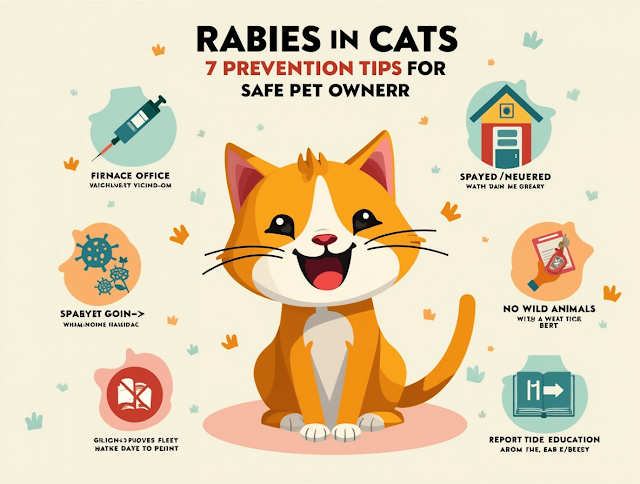Rabies in Cats: 7 Prevention Tips for Safe Pet Ownership
 |
| Discover essential prevention tips to protect your cat from rabies and ensure their safety and health. |
Rabies in Cats: 7 Prevention Tips for Safe Pet Ownership
Introduction
Rabies is a serious disease that can affect cats and other animals, including humans. It’s caused by a virus that attacks the brain and spinal cord. Understanding rabies is important for every cat owner. In this blog post, we’ll discuss why prevention is crucial and share helpful tips to keep your furry friends safe from rabies in cats.
Understanding Rabies in Cats
What is Rabies?
Rabies is a viral infection that can be deadly. It spreads through bites or scratches from infected animals. Once a cat is infected, the virus can take weeks or even months to show symptoms. During this time, the cat can still spread the virus to other animals.
When a cat gets rabies, it affects their nervous system. This can lead to serious health issues, including confusion, aggression, and even paralysis. That’s why cat owners need to understand what rabies is and how it spreads.
Symptoms of Rabies in Cats
Recognizing the symptoms of rabies in cats is vital for early detection. Here are some common signs to watch for:
- Behavior Changes: Your cat might become more aggressive or unusually shy.
- Excessive Drooling: Look for drooling that seems out of the ordinary.
- Lack of Appetite: If your cat suddenly stops eating, it could be a sign of illness.
- Difficulty Walking: Watch for stumbling or lack of coordination.
It’s important to note that these symptoms can resemble those of other illnesses. If you notice any of these signs, it’s best to consult your veterinarian right away.
The Risks of Rabies for Pet Owners
Rabies is not just a threat to cats; it can also be dangerous for humans and other pets. When a rabid cat bites or scratches someone, the virus can enter the human body, leading to serious health issues. This is why awareness and education about rabies in cats are so important.
By keeping your cat vaccinated and informed about rabies, you can help protect not only your pet but your family as well.
7 Prevention Tips for Rabies in Cats
1. Vaccination
Vaccinating your cat against rabies is one of the best ways to prevent the disease. Vaccines help your cat build immunity against the virus. Here are some important points about vaccination:
- Importance: Vaccination significantly reduces the risk of rabies in cats.
- Schedule: Kittens should receive their first rabies vaccine at around 12 weeks of age, with booster shots every one to three years, depending on local laws and vet recommendations.
2. Regular Vet Check-ups
Regular visits to the vet are crucial for your cat's health. During these check-ups, you can discuss rabies and ensure your cat is up-to-date on vaccinations. Here’s what to focus on during vet visits:
- Discuss Vaccination Status: Always check if your cat's rabies vaccine is current.
- Health Monitoring: Regular check-ups can help catch any potential health issues early.
3. Keep Cats Indoors
Keeping your cat indoors is one of the most effective ways to prevent exposure to rabies. Indoor cats are less likely to encounter wild animals that may carry the virus. Here are some tips to make indoor life enjoyable for your cat:
- Create a Fun Environment: Provide toys, scratching posts, and places to climb.
- Interactive Play: Spend time playing with your cat to keep them stimulated and happy.
4. Spay and Neuter
Spaying and neutering your cat can also help reduce the risk of rabies. Here’s how:
- Population Control: Fewer stray cats mean a lower chance of rabies spreading in the community.
- Behavioral Changes: Spayed and neutered cats tend to be less aggressive and are less likely to roam.
5. Avoid Contact with Wild Animals
Educating yourself about the risks of wild animal interactions is essential. Wild animals can carry rabies and may pose a threat to your cat. Here’s what to do:
- Supervise Outdoor Time: If your cat goes outside, keep a close eye on them to prevent encounters with wild animals.
- Teach Caution: Make sure your family understands the importance of not approaching wild animals.
6. Report Stray Animals
If you see stray or potentially rabid animals in your area, it’s important to report them. Local authorities can help manage these animals safely. Here’s why reporting is crucial:
- Community Safety: Reporting strays helps protect other pets and people in your neighborhood.
- Professional Assistance: Animal control can handle potentially rabid animals, keeping everyone safe.
7. Educate Yourself and Others
Knowledge is power! The more you know about rabies in cats, the better you can protect your pet. Here are some resources to consider:
- Local Animal Control: Check your local animal control for information and resources on rabies.
- Veterinary Clinics: Ask your vet for educational materials about rabies prevention.
Conclusion
Preventing rabies in cats is essential for your pet's and your family's safety. By following these seven tips—vaccination, regular vet check-ups, keeping cats indoors, spaying and neutering, avoiding wild animals, reporting strays, and educating yourself—you can help ensure that your furry friend stays healthy and safe.
Let’s work together to spread awareness about rabies in cats. Share this post with fellow cat owners and help keep our pets protected!
Additional Resources
- Centers for Disease Control and Prevention (CDC) - Rabies
- American Veterinary Medical Association (AVMA) - Rabies
- Your Local Animal Control Office
By staying informed and proactive, we can keep our cats safe from rabies and ensure they live long, healthy lives!






